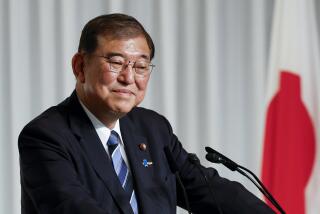A Win for (Hair) Style, Substance
- Share via
TOKYO — It may not be Camelot. But the breeze blowing through politics here this week is every bit as refreshing to the average Japanese as was John F. Kennedy’s leap to the Oval Office in 1961 to many Americans.
The administration of Prime Minister Junichiro Koizumi, a ruling Liberal Democratic Party member who swept into power Thursday promising reform, faces lots of problems and has little time. With elections for the upper house of parliament just 12 weeks away, there’s not much opportunity to show results. That makes symbolism very important.
Symbolism can do a lot for a nation beaten down by a decade of bad news, corruption and economic pain.
For the first time in years, Japanese feel some hope that there’s a way out of the darkness that has so corroded self-confidence in this once-proud nation. And even if it’s just a couple of weeks before the dark shadows return, it sure feels better than the endless bouts of depression.
The palace revolt that saw dark horse candidate Koizumi muscle his way into leadership on the wings of grass-roots discontent has deepened the public appetite for details great and small. From tabloids to respected newspapers, the media are obsessing over Japan’s quirky new leader, his likes and dislikes, his physique, weight and blood type, and the jousting between the new crowd and the LDP’s ancien regime. Suddenly, many Japanese feel that they have a stake in national politics.
It’s the very early days. But a picture is emerging of what’s hot and what’s not in the gilded era of “Koizumi-ism.” The watchwords are change, upheaval, reform. Even if he can’t deliver, many say, let’s see where this goes.
“The new ship Koizumi is on an unknown course,” noted one newspaper.
* Young and restless: Koizumi’s Cabinet is young and vibrant, with a record five women and several outsiders, in contrast to the stodgy profile of past LDP administrations. On average, its members are 4.6 years younger than the first Cabinet of just-departed Prime Minister Yoshiro Mori. This is still Japan, however: The average age of Cabinet members is 61.5 years. But it’s a start.
* Bouncy, not greasy: Koizumi’s defining characteristic, the counterpart to President Nixon’s nose, Betty Grable’s legs and Mikhail S. Gorbachev’s birthmark, is his shaggy mop of permed hair. Like its owner, the mane shows every sign of having a mind of its own. Koizumi’s victory over party insider Ryutaro Hashimoto, known for his ‘50s-style slicked-back hair, represents the tress-related triumph of freedom over constraint.
This week has given Koizumi’s barber of 34 years more than his 15 minutes of fame. Teruo Nakagomi of Nakagomi Cuts says the secret to the low-maintenance do of his famous customer is Buru Kon--blue conditioner--that Koizumi slathers on daily between quarterly chemical hair-curling sessions.
Fellow barber and wife Tomoko Nakagomi, who has been doing Koizumi’s perm all these years, says phone calls are pouring in as word spreads of the magic blue goo--actually Alberto VO5 Consort gel made under Japanese license. “We’re very honored,” said publicist Yasuo Hashimoto of the distributor, Sunstar. “The Hashimoto look was too tight and shiny, but this is soft and casual.”
* Direct dial: Meddlesome intermediaries are out, straightforward communication is in. Koizumi, who is fluent in English, has called for direct election of the prime minister, eschews off-the-record whispering to reporters and advocates clear lines of government responsibility.
And a shocking development: Koizumi decided on many of his Cabinet ministers himself, then called his choices directly to ask if they would accept. For as long as anyone can remember, Japan’s top leaders have been told by powerful underlings who to name. This left many Cabinet wannabes clinging to their cell phones in the hours before the final announcement.
* Keio versus Waseda: Two prestigious Japanese universities have been in a sumo match for many a cherry-blossom season over whose graduates have greater clout. Keio graduate Koizumi has given a high-profile fillip to his university in the Japanese equivalent of the Harvard versus Yale rivalry. On Thursday, Koizumi named four Keio alumni to his inner circle and only three Waseda grads. Keio, naturally, is beside itself. “We’re delighted,” said Kiyoyuki Miyamori, a university publicity official named to a new unit set up to answer Koizumi questions.
Given Japan’s famous attention to detail, there are statistics to pore over. Taking into account Koizumi’s picks, Keio has had 62 graduates in Cabinets since 1989 to Waseda’s 63.
* Don’t worry, be wacky: Over the years, Koizumi has been called eccentric, quixotic, a weirdo and a heretic as he proselytized for reform to anyone who would listen. Most didn’t. This week that all changed, and with it has come some respect for all things a bit weird and for individuality over conformity.
Koizumi, 59, is not your average boring LDP official. He has a life outside politics and loves heavy metal music, pro wrestling and kick boxing. He is divorced and a single parent who raised two sons. He’s been known to wear bright colors and beige sweaters as opposed to the consistent dull suits worn by most party stalwarts. (Referring to one Hashimoto sighting involving a gray turtleneck sweater and dark double-breasted jacket, a fashion critic wrote this week: “Hashimoto looked like he was going to suffocate. Just looking at him made me feel nauseous.”)
* Loner versus wolf pack: Politicians tend to avoid being alone; it’s more difficult to feel important without an audience of constituents and hangers-on. But solitude takes on a new shine this week, as Japanese learn that Koizumi has traveled for years by himself on ordinary trains. He knows how to buy tickets, goes CD shopping solo and seems to understand how real people live.
He’s been sighted reading alone in the parliament library and enjoys attending Kabuki performances and watching movies by himself, including such recent favorites as “Gladiator.” His independence is also seen in his dislike of gift giving, which quickly leads to a web of obligations in polite Japan, and in his distrust of factional politics.
* Crowd-filled sidewalks versus smoke-filled rooms: Put the humidor away, it’s time to head out into the street. Aides kept reminding Koizumi during the campaign for party president, a step toward the premiership, that his speeches to Tokyo crowds were a waste of time because party insiders weren’t present. Better to talk to the gray-suited stiffs in the corridors of power who really control things.
Koizumi ignored the advice. And lo and behold, pressure flowed from the street to the low-level LDP hacks to the high-level LDP hacks and into the parliament, forcing the party’s power brokers to accept his candidacy against their will. That said, defying Japanese political gravity for an extended period would be a nifty trick indeed.
* Shout, don’t mumble: Koizumi has railed against tamamushiiro, or weasel words. This stock in trade for a generation of LDP politicians makes for maximum negotiating room but can leave policy unclear.
Koizumi has vowed to, in his first nationwide policy speech--scheduled for May 7--set out clear and direct goals, even as he warned in advance that he’s not going to please everyone. And he named as his foreign minister the firebrand politician Makiko Tanaka, referred to as “the Bulldozer” by critics for her blunt approach. “She speaks so clearly,” an anonymous Foreign Ministry bureaucrat complained to the Asahi Shimbun newspaper. “We’re in for a tough time.”
* Stop gritting those teeth: The new crowd is taking more account of public opinion than LDP opinion. A photo spread in the Nikkei newspaper Friday under the headline “Surprise and Passion--Welcome Aboard the Good Ship Koizumi” takes note of the Cabinet’s very different style: Smile, be graceful, speak directly and be provocative.
Says outgoing Finance Minister Kiichi Miyazawa: “In my nearly 50 years of Japanese politics, this is the first time I’ve felt such a free atmosphere. I hope he can do what he’s outlined.”
That said, Japanese media and the public can be very fickle. Noted Gerald Curtis, Columbia University professor and longtime Japan watcher: “This fellow has to keep riding this bicycle at full speed in order to keep his support rating up.”
More to Read
Sign up for Essential California
The most important California stories and recommendations in your inbox every morning.
You may occasionally receive promotional content from the Los Angeles Times.










